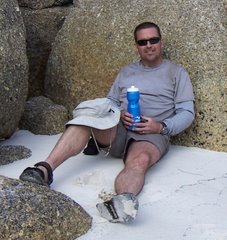

I've just returned from a fabulous holiday to ... guess where?
Apart from the obvious enjoyment that one gets from holidaying in exotic locations - quaffing croissants, fine French wine and massacring local languages - one of the real pleasures of holidays for me is the chance to put my mind in a more neutral mode and to discover new things.
There are many things to discover in France, and I was able to do more than my fair share. But one particular discovery still sticks in my mind. It was the visit my wife and I enjoyed to the Musee Picasso in Paris.
I would be the first to admit that I am not much of an art buff, but when you do visit Paris, it's hard not to be taken in by the Louvre, the Pompidou centre etc. But the Picasso museum, for me, meant a whole lot more.
There's been lots written and said about Pablo Picasso, but most of us probably just know scraps about his most famous works like Guernica, or his relationships with the many women in his life.
But what was most interesting to me, was seeing his many, many sketchbooks that were on display at the Musee. Throughout these sketch books, and also on many pieces of scrap paper and cardboard, are literally thousands of his practice drawings and studies. As you move from room to room in the Musee, you can sense how Picasso developed his interests, his focus and his skills. He could paint and draw in a natural way, but clearly that was not enough for him - he was attracted to some different artistic challenge. So over his 91 years, Picasso continued to develop his skills and his interests. (Want to see more?)
So how does the art of Pablo Picasso relate to leadership?
To me, the key link is how even the naturally gifted work on their skills to get even better. No one would dispute that Picasso was a naturally talented painter, sketch artist and sculptor. But his natural talent was not enough. He continued to work on his skills throughout his life. He experimented with different media, styles, models and approaches. And by doing this, he transformed the style of painting and sculpting that was popular at the time.
How often do we sit down and fill a sketch book with our ideas?
How often do we look at a situation, and then "paint" it dozens of different ways?
How often do we try a new style, a new medium or a new model?
The big question is, what can Pablo Picasso teach us about how to approach our leadership art?
Apart from the obvious enjoyment that one gets from holidaying in exotic locations - quaffing croissants, fine French wine and massacring local languages - one of the real pleasures of holidays for me is the chance to put my mind in a more neutral mode and to discover new things.
There are many things to discover in France, and I was able to do more than my fair share. But one particular discovery still sticks in my mind. It was the visit my wife and I enjoyed to the Musee Picasso in Paris.
I would be the first to admit that I am not much of an art buff, but when you do visit Paris, it's hard not to be taken in by the Louvre, the Pompidou centre etc. But the Picasso museum, for me, meant a whole lot more.
There's been lots written and said about Pablo Picasso, but most of us probably just know scraps about his most famous works like Guernica, or his relationships with the many women in his life.
But what was most interesting to me, was seeing his many, many sketchbooks that were on display at the Musee. Throughout these sketch books, and also on many pieces of scrap paper and cardboard, are literally thousands of his practice drawings and studies. As you move from room to room in the Musee, you can sense how Picasso developed his interests, his focus and his skills. He could paint and draw in a natural way, but clearly that was not enough for him - he was attracted to some different artistic challenge. So over his 91 years, Picasso continued to develop his skills and his interests. (Want to see more?)
So how does the art of Pablo Picasso relate to leadership?
To me, the key link is how even the naturally gifted work on their skills to get even better. No one would dispute that Picasso was a naturally talented painter, sketch artist and sculptor. But his natural talent was not enough. He continued to work on his skills throughout his life. He experimented with different media, styles, models and approaches. And by doing this, he transformed the style of painting and sculpting that was popular at the time.
How often do we sit down and fill a sketch book with our ideas?
How often do we look at a situation, and then "paint" it dozens of different ways?
How often do we try a new style, a new medium or a new model?
The big question is, what can Pablo Picasso teach us about how to approach our leadership art?


No comments:
Post a Comment